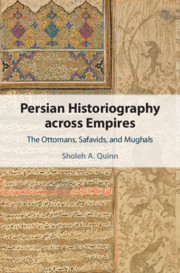Book contents
- Persian Historiography across Empires
- Persian Historiography across Empires
- Copyright page
- Dedication
- Contents
- Tables
- Acknowledgments
- 1 Introduction
- 2 Continuity and Transformation
- 3 Historiography and Historians on the Move
- 4 The First King of the World
- 5 Mirrors, Memorials, and Blended Genres
- 6 Conclusion
- Appendix The Chroniclers and the Chronicles
- Bibliography
- Index
5 - Mirrors, Memorials, and Blended Genres
Published online by Cambridge University Press: 21 November 2020
- Persian Historiography across Empires
- Persian Historiography across Empires
- Copyright page
- Dedication
- Contents
- Tables
- Acknowledgments
- 1 Introduction
- 2 Continuity and Transformation
- 3 Historiography and Historians on the Move
- 4 The First King of the World
- 5 Mirrors, Memorials, and Blended Genres
- 6 Conclusion
- Appendix The Chroniclers and the Chronicles
- Bibliography
- Index
Summary
The chapter argues for the importance of being familiar two literary traditions that made their way into Persianate histories. The first tradition is Mirrors for Princes. The chapter demonstrates that it is possible to view certain portions of Persian histories as “responses” to “mirrors for princes.” Several Persian histories contain a conventional element that describes the qualities of a particular king.This section demonstrates how narratives on the “qualities” of the Safavid king ‘Abbas and the Mughal king Akbar reflect the same ideal qualities that a king is supposed to possess, as indicated in the mirrors for princes literatures.The second tradition explored is the tazkirah, or biographical dictionary.Like the mirrors for princes literatures, the tazkirah is a genre in its own right that flourished during the Timurid era. Some Ottoman, Safavid and Mughal histories contain their own “mini-tazkirah” sections.The chapters trace the historiographical influences on the mini-tazkirahs, and show just how influential Mirkhvand and Khvandamir were for chroniclers writing under the Ottomans, Safavids, and Mughals. The chapter also explains how the chroniclers’ political agendas were reflected in how they used tazkirah to highlight the royal courts where many of them wrote.
Keywords
- Type
- Chapter
- Information
- Persian Historiography across EmpiresThe Ottomans, Safavids, and Mughals, pp. 155 - 201Publisher: Cambridge University PressPrint publication year: 2020



